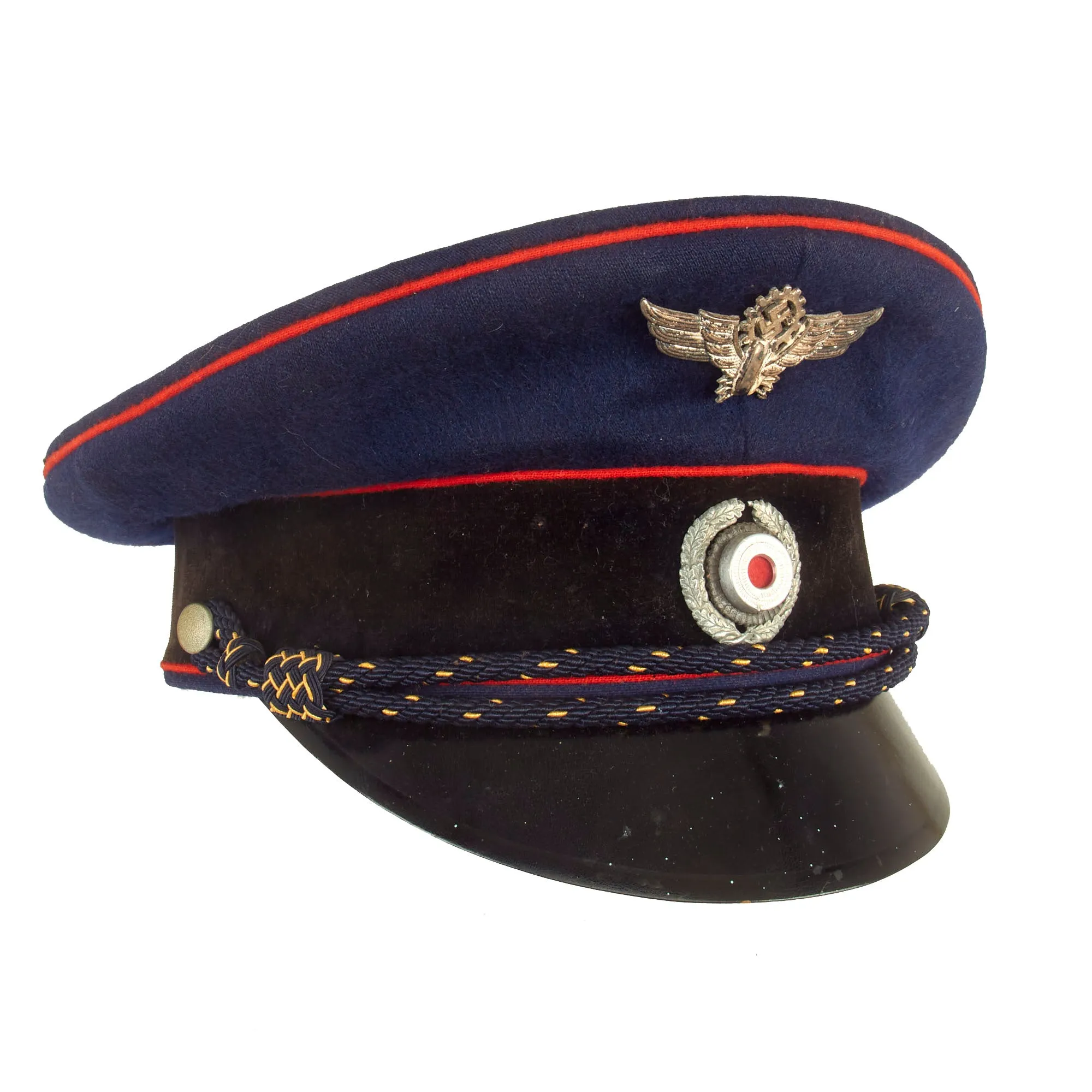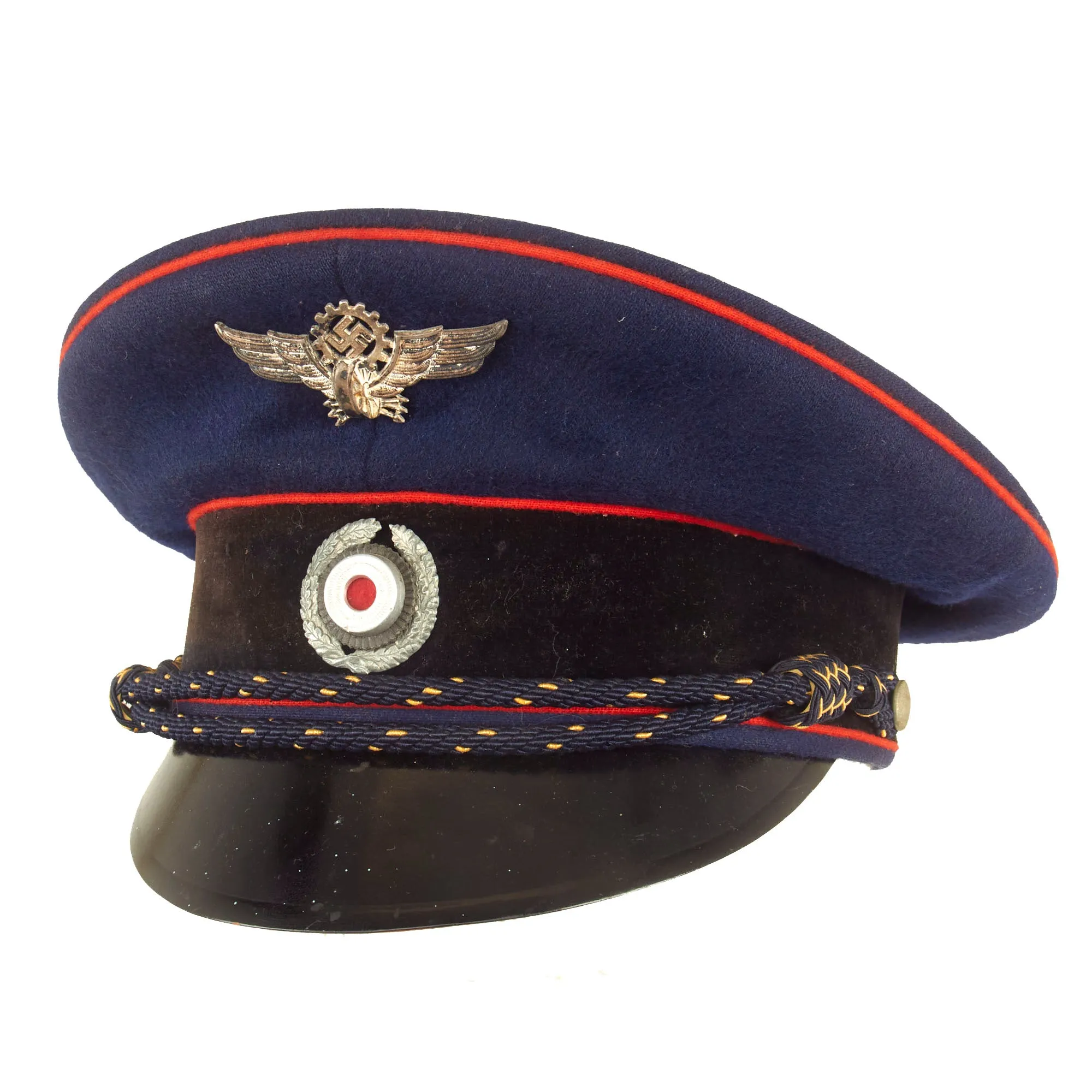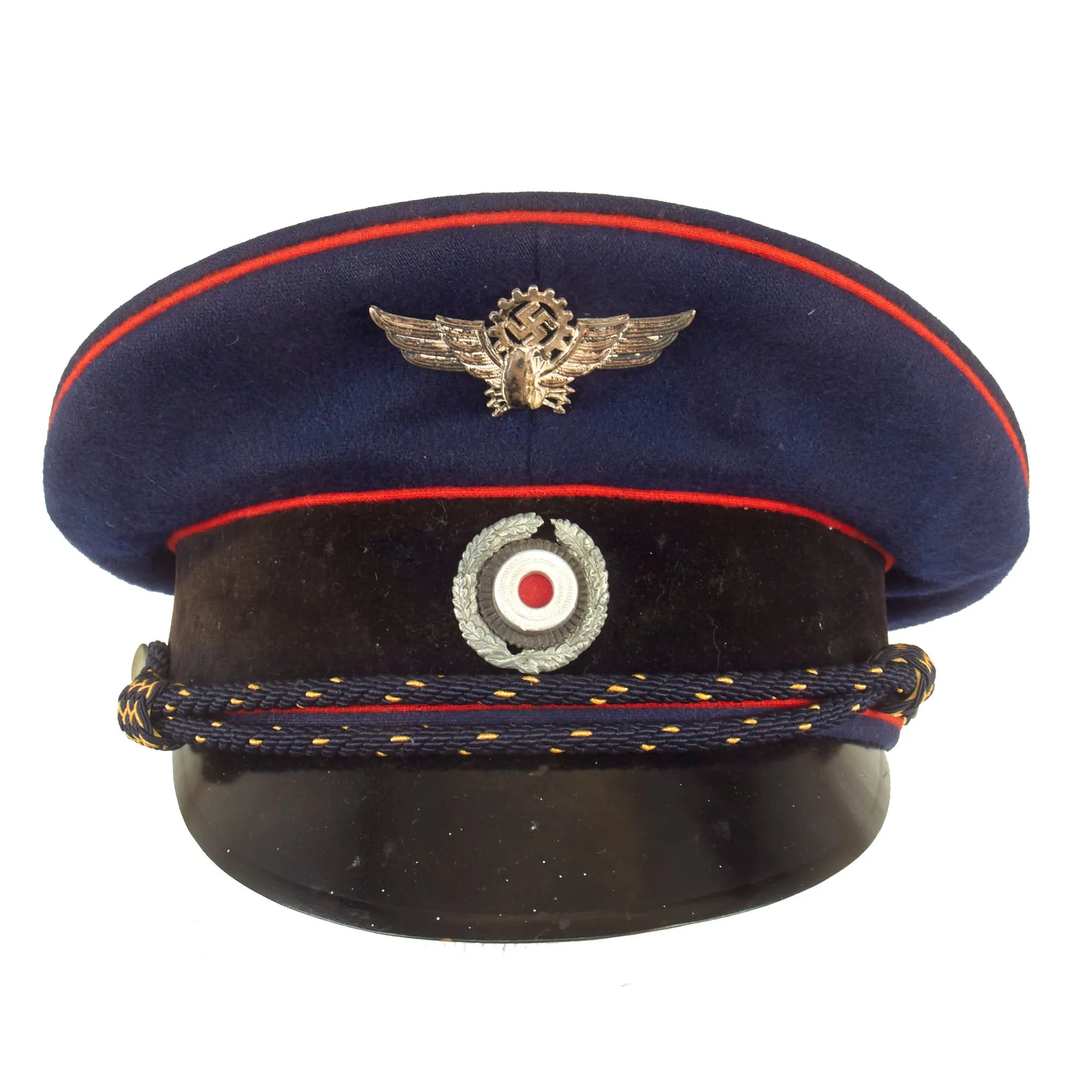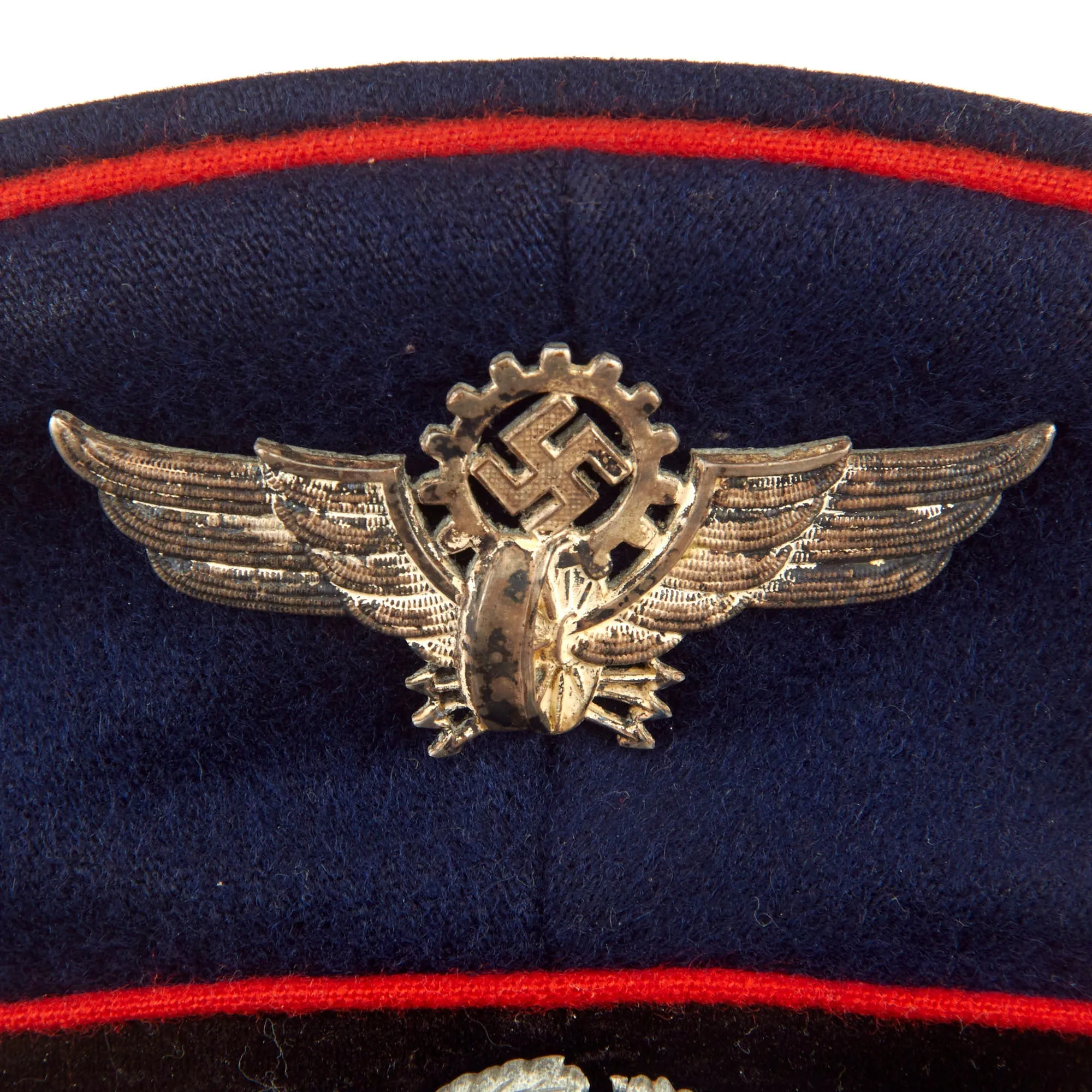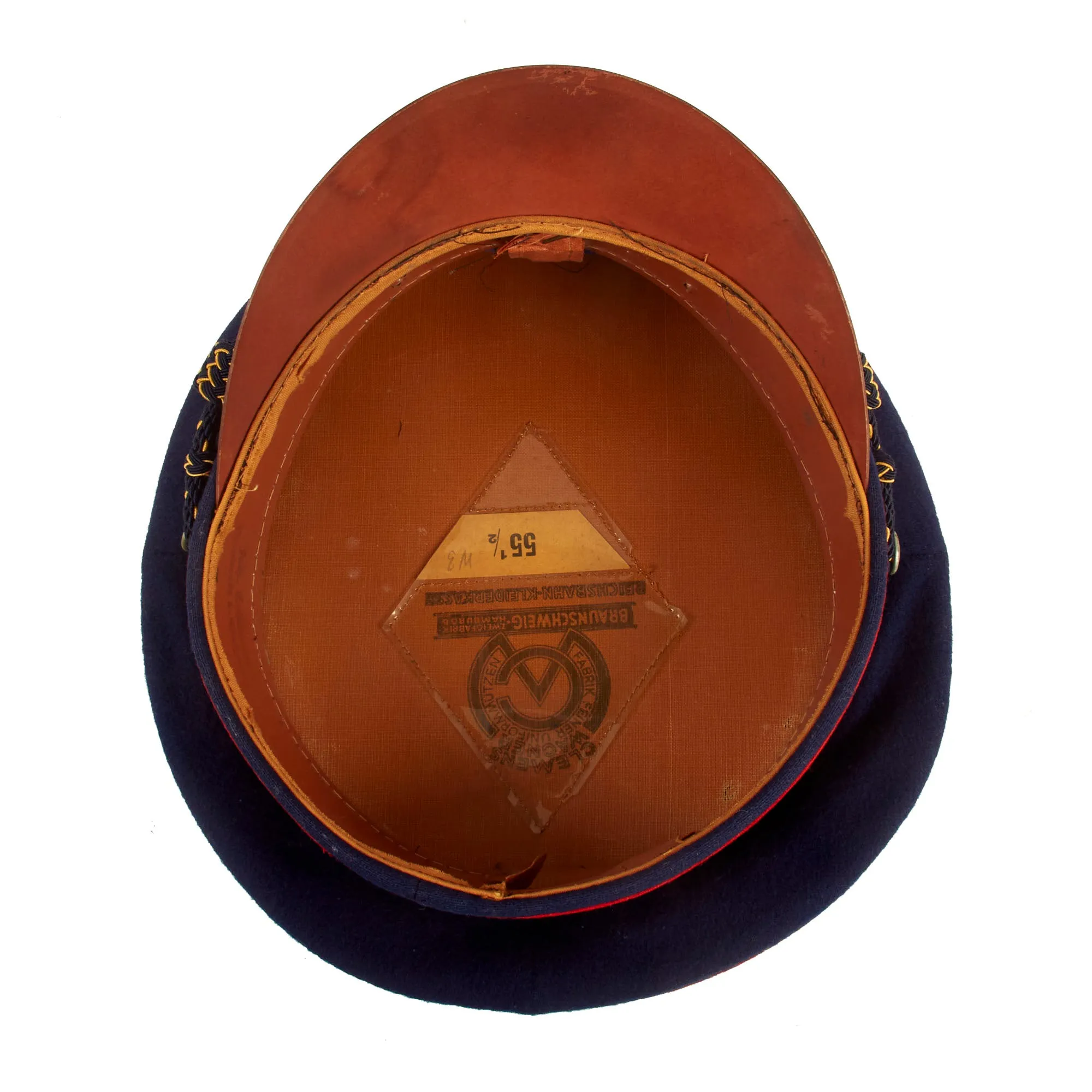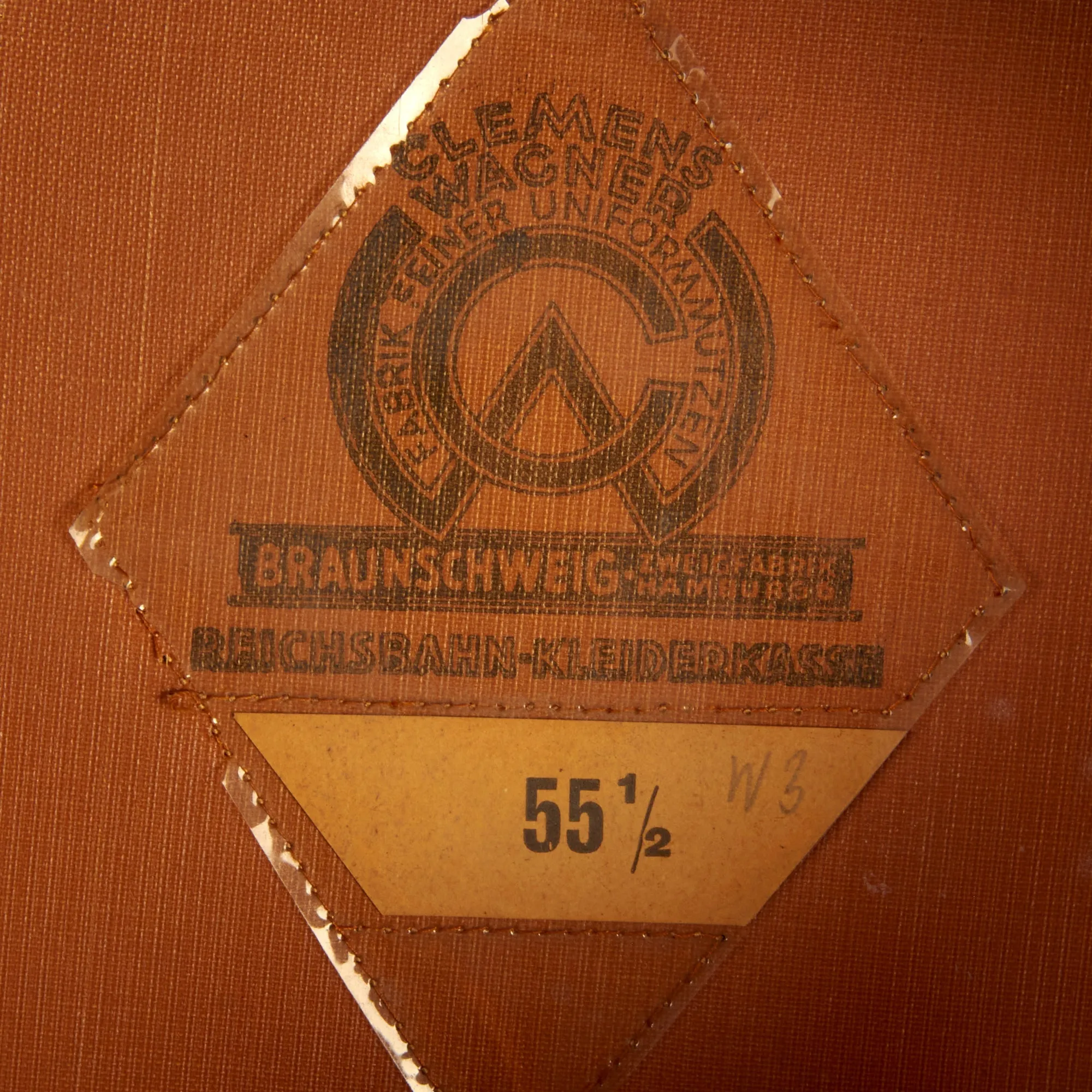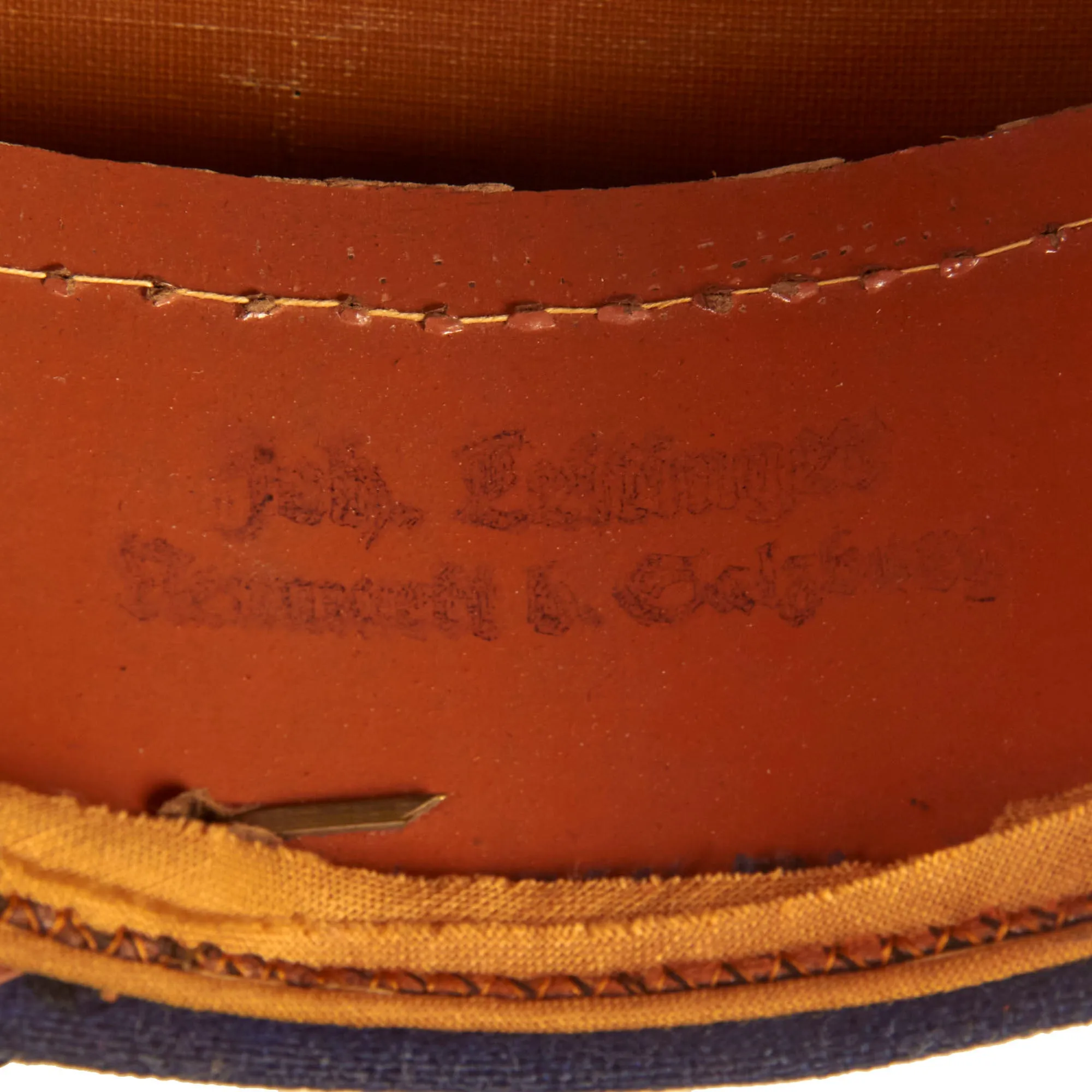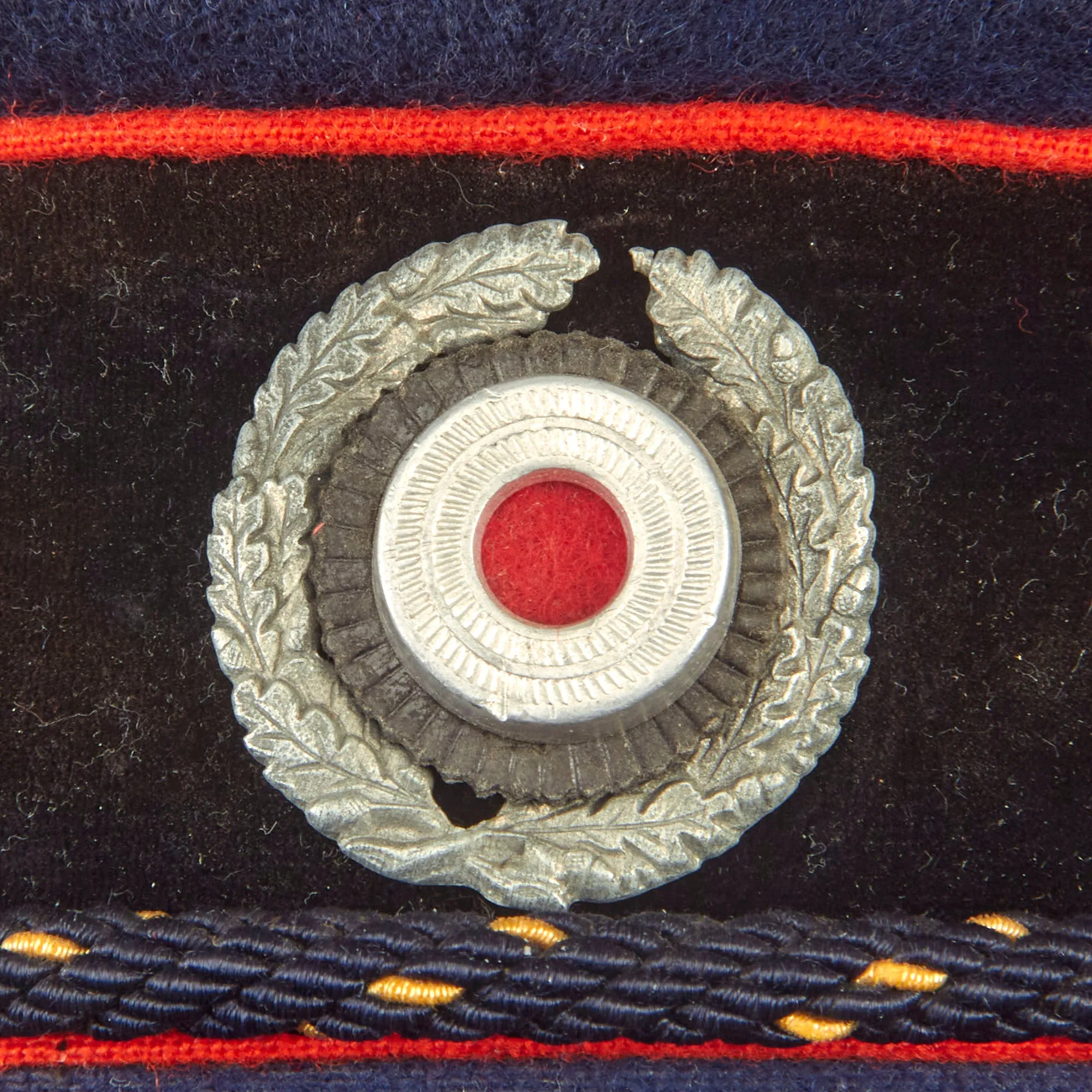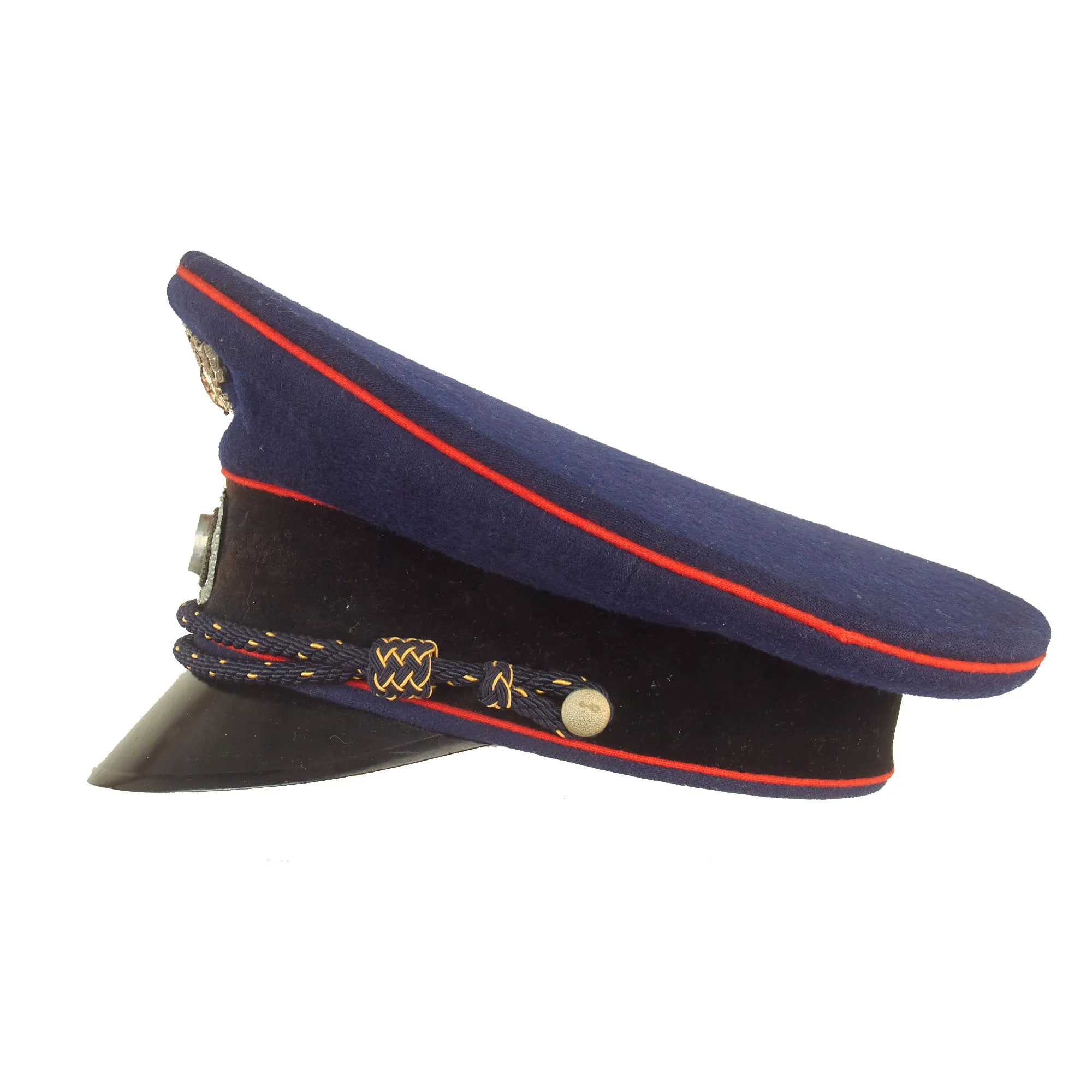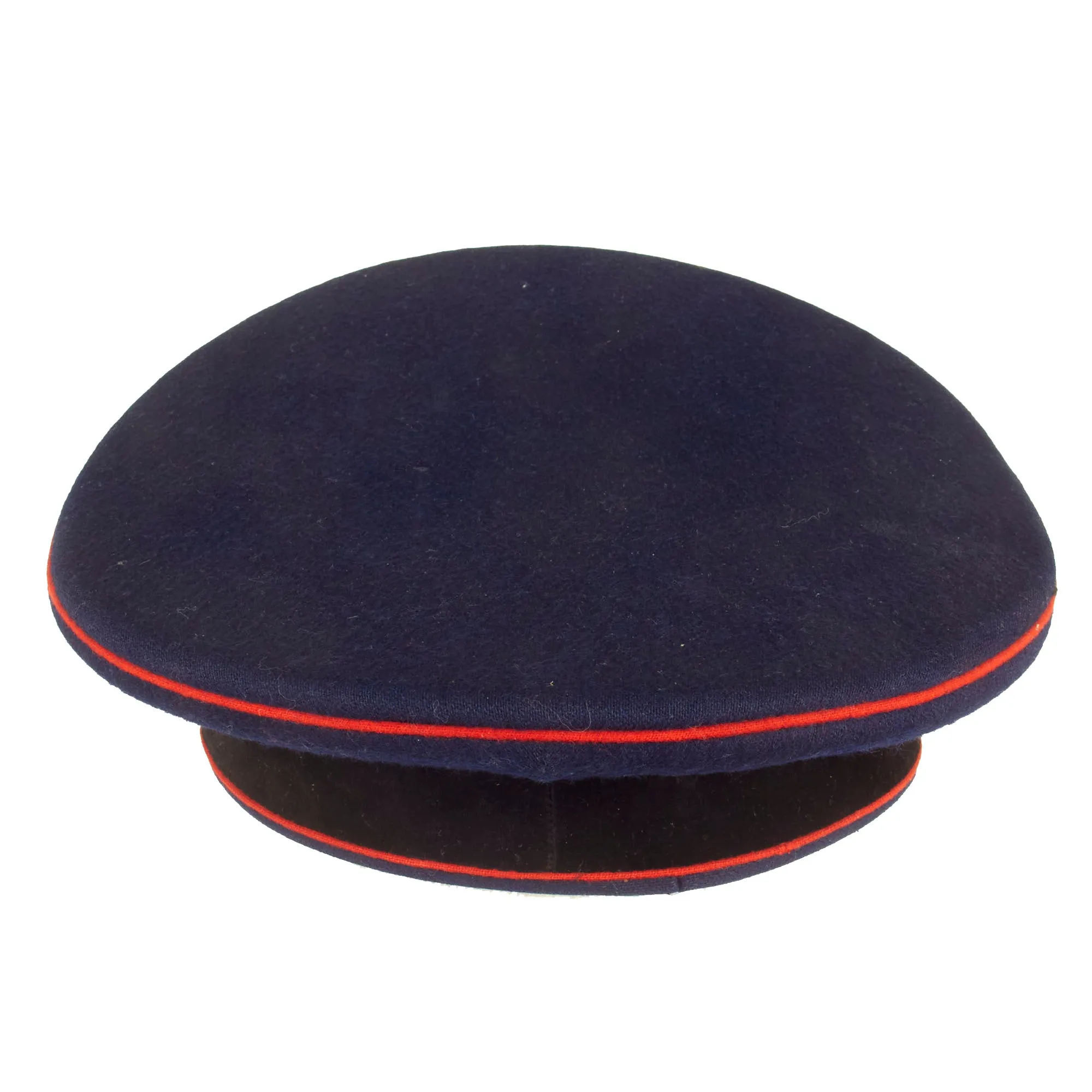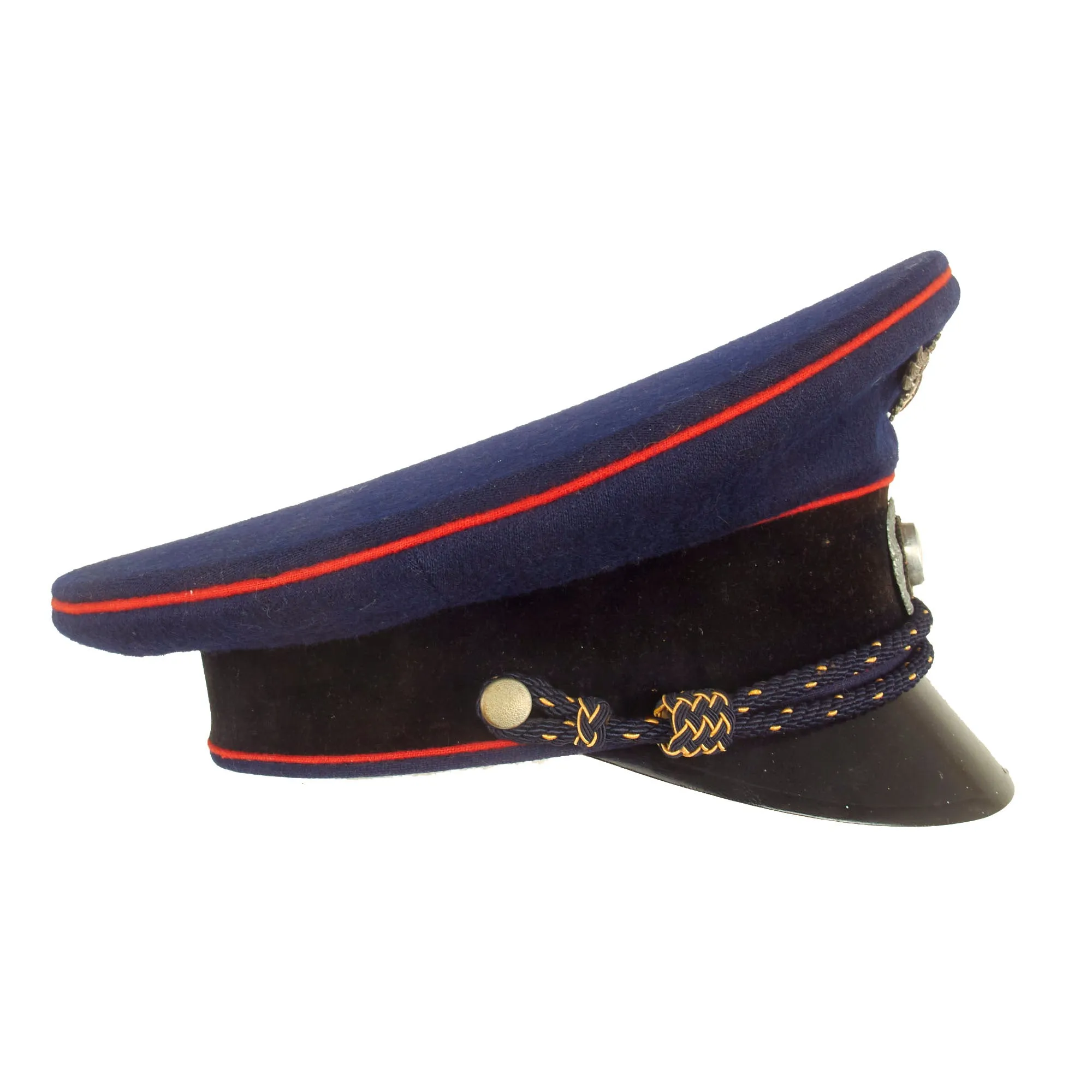Original Item: Only One Available. This is a very attractive and interesting example of a Deutsche Reichsbahn schirmmütze visor cap, with a cap insignia and chin strap indicating that the wearer is a DAF Labor Front Railway Leader. The cap was produced by the desirable and well-known firm of Clemens Wagner, and is size marked 55 ½. The cap is in very good condition, though the sweatband is unfortunately almost completely missing. During the Third Reich period, the DAF Labor front became the only trade union allowed, and this of course also affected the DRB. Leader's in the Union wore caps indicating their station, and these caps definitely are very seldom found
The visor cap features navy blue wool construction on the crown, with a lovely black velvet cap band that is in great shape. This is bordered by the correct red piping for DRB caps, and has another row of piping around the crown of the cap. The crown stiffener is still installed, so the crown is still in the correct shape, showing only a gentle curve. The cap has a leader's chinstrap, which is navy blue with gold bullion woven in, and retained by pebbled buttons on the ends.
The front features a combined DAF Gear and DRB winged wheel cast metal insignia, which also shows three arrows below the wheel on each side. We have only been able to find a few examples of this rare insignia, and we were not able to find what that arrows at the bottom of the insignia mean. Under this is a metal tri color cockade made partially from aluminum, which has a zinc oak leaf wreath around it. The center of the cockade still retains the bright red felt insert. The visor on the cap looks to be the standard vulcanfibre or something similar, and is in very good condition.
The interior is lined with orange "service cloth" type fabric, and originally had a brown pressed paper faux leather sweatband, which is now 90% missing. The crown celluloid diamond is mostly intact, and still has the manufacturers name and address in black underneath, along with the CW monogram logo:
CLEMENS
WAGNER
FABRIK FEINER UNIFORMMÜTZEN
BRAUNSWCHWEIG ZWEIGFABRIK
HAMBURG 6
REICHSBAHN-KLEIDERKLASSE
The last line indicates official contract and issue by the Reichsbahn clothing office, and in the name tag slot is a size label reading 55 ½. There is also a faint marking on the fiber side support band, which we unfortunately cannot read, but might be a name.
Overall a very nice condition example of a rare German WW2 cap, ready to research and display!
The Visor Cap-
The visor cap (Schirmmütze) was an important part of the headgear worn by German uniformed military, civil, paramilitary and political organizations during the Third Reich. This was the standard cloth headgear worn as a part of the service uniform. Visor caps were worn outdoors as well as indoors, and were often required to be worn by all personnel on duty. Visor caps were made in versions specific to each organization and were often further differentiated through the use of insignia, colored piping, or style of chin cord, to indicate rank, role or branch. The insignia used on these caps ranged from simple stamped metal emblems, to elaborate hand embroidery. Visor caps were issued to enlisted soldiers and NCOs in the military and in some other organizations. Officers had to purchase their own hats, and lower ranks could choose to purchase caps that were of a higher quality than the rather basic, issue examples. The private purchase caps were generally made in very high quality, with fine materials. A wide variety of fabrics were used, from Trikot and doeskin, to heavy wool, or even lightweight white fabric for summer wear. In the military, issue of these caps was generally suspended shortly after the outbreak of the war, but they continued to be worn by some troops until the end of the war.
Deutsche Arbeitsfront (German Labor Front or DAF):
With the dissolution of all Free Trade Unions in Germany in May 1933 the Deutsche Arbeitsfront, (German Labor Front), was established to replace the unions and to educate the workers in industry and commerce for smooth and efficient operation of all labor in the Third Reich. In October 1934 the DAF was given official status as a sub-section of the NSDAP and in March 1936 it was recognized as an independent NSDAP affiliated association and granted control of its own monetary budget. With this money it was able to procure its own signs and other insignia.
Deutsche Reichsbahn (1937 to 1945)-
With the Act for the New Regulation of the Conditions of the Reichsbank and the Deutsche Reichsbahn (Gesetz zur Neuregelung der Verhältnisse der Reichsbank und der Deutschen Reichsbahn) of 10 February 1937 the Deutsche Reichsbahn Gesellschaft was placed under Reich sovereignty and was given the name Deutsche Reichsbahn.
World War II and military use-
The Reichsbahn had an important logistic role in supporting the rapid movement of the troops of the Wehrmacht, for example:
In all the occupied lands the Reichsbahn endeavored to incorporate the captured railways (rolling stock and infrastructure) into their system. Even towards the end of the war the Reichsbahn continued to move military formations. For example, in the last great offensive, the Battle of the Bulge (from 16 December 1944), tank formations were transported from Hungary to the Ardennes.
The railways managed by the "Eastern Railway Division" (Generaldirektion der Ostbahn) were initially run from that part of the Polish State Railways within the so-called General Government gelegene Teil der Polnischen Staatsbahnen (PKP), but from November 1939 by the Ostbahn (Generalgouvernement).
In the campaigns against Poland, Denmark, France, Yugoslavia, Greece etc. the newly acquired standard gauge networks could be used without difficulty. By contrast, after the start of the invasion of Russia on 22 June 1941, the problem arose of transferring troops and materiel to Soviet broad gauge lines or converting them to German standard gauge. Confounding German plans, the Red Army and Soviet railways managed to withdraw or destroy the majority of its rolling stock during its retreat. As a result, German standard gauge rolling stock had to be used for an additional logistic role within Russia; this required the laying of standard gauge track. The price was high: Reichsbahn railway staff and the railway troops of the Wehrmacht had to convert a total of 16,148 kilometres of Soviet trackage to German standard gauge track between 22 June and 8 October 1941.
During the war, locomotives in the war zones were sometimes given camouflage livery. In addition, locomotives were painted with the Hoheitsadler symbol (the eagle, Germany's traditional symbol of national sovereignty) holding a swas. On goods wagons the name "Deutsche Reichsbahn" was replaced by the letters "DR". Postal coaches continued to bear the name "Deutsche Reichspost".
The logistics of the Reichsbahn were crucial to the conduct of Germany's military offensives. The preparations for the invasion of Russia saw the greatest troop deployment by rail in history.
Expansion-
Characteristic of the first six and a half years of this period was the exponential growth of the Deutsche Reichsbahn, which was almost exclusively due to the takeover of other national railways. This affected both parts of foreign state railways (in Austria the entire state railway) in the countries annexed by the Deutsche Reich, as well as private railways in Germany and in other countries:
The logistics of the Reichsbahn were also an important factor during the Shoah. Jews were transported like cattle to the contingent and extermination camps by the Deutsche Reichsbahn in trains of covered goods wagons, so-called Shoah trains. These movements using cattle wagons, for example, from the goods station of the great Frankfurt Market Hall thus played a significant role in the genocide within the extermination machinery of the Shoah.
Breakup of the Reichsbahn-
With the end of the Second World War in 1945 those parts of the Deutsche Reichsbahn that were outside the new German borders laid down in the Potsdam Agreement were transferred to the ownership and administration of the states in whose territory they were situated. For example, on 27 April 1945, the Austrian railways became independent again as the Austrian State Railway (Österreichische Staatseisenbahn or ÖStB), later renamed as the Austrian Federal Railways (Österreichische Bundesbahnen or ÖBB) on 5 August 1947.




